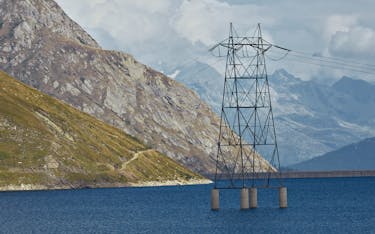
The EU is working flat out to finalise the single electricity market and is making progress with the implementation of the third internal market package. At the same time, the «Clean Energy Package» has come into force. This is now being applied in phases, which is not without consequences for Switzerland. The Clean Energy Package includes a measure referred to as the 70% rule. This specifies that from 1 January 2020, EU member states must make at least 70% of the capacity of their grid elements available for trade between EU member states. Some countries have made use of the exemption to increase this capacity allocation gradually by the end of 2025. An increase in trade within the EU is to be expected as a result of the implementation of the 70% rule.
There are different interpretations of how to deal with non-EU states like Switzerland. At the moment, however, it can be assumed that without corresponding agreements, electricity flows with non-EU states do not count towards this 70%. Increased trade will lead to new challenges for the Swiss transmission grid, especially if trade with Switzerland is not taken into account.
Planned and unplanned electricity flows
There are different flows in the electricity grid, which can be roughly divided into planned and unplanned electricity flows. Planned flows correspond to the electricity trade carried out between different countries. If, for example, Germany sells electricity to France and the electricity flows directly across the border from Germany to France, then this is a planned import-export electricity flow. Often, however, only some of the electricity flows directly across the border in this type of trade for physical reasons. The rest of the flow seeks a path via other countries, thereby creating unplanned flows. If, for example, Germany sells electricity to France, part of this electricity inevitably flows as an unplanned transit flow via another country, such as Belgium. Both types of electricity flow appear in cross-border trade and therefore count towards the 70% set out in the EU rule.
A ring flow is another kind of unplanned electricity flow. It occurs when, for example, Germany trades electricity within its own country, but this electricity flows back to Germany via another country, for example through Switzerland. The electricity produced within a country is therefore consumed in the same country, but transits via foreign lines in the process. Due to grid expansion in European countries, ring flows can be minimised, but never completely prevented. This is because electricity always seeks the path of least physical resistance. A ring flow is therefore a cross-border flow that exists from a physical perspective but does not appear in cross-border trade. Consequently, ring flows do not count towards the 70% laid down in the EU rule.
This means that after full implementation of the 70% rule in the EU, the proportion of the transfer capacity that will be available for export to Switzerland is not actually 30% in accordance with a simplistic application of the calculation, but less. And that’s not all.
There are different flows in the electricity grid, which can be roughly divided into planned and unplanned electricity flows.
Impact on Switzerland
Swissgrid expects trading within the EU to increase as a result of the implementation of the 70% rule. Until sufficient account is taken of Switzerland in the necessary grid capacity calculation processes, a massive increase in unplanned electricity flows through Switzerland can be expected. Going back to transit and ring flows for a moment, there is a risk that situations will arise more frequently in which Swissgrid grid elements are overloaded. Swissgrid must then intervene in grid operations to keep the transmission grid stable. This will involve additional work and higher costs.
Furthermore, if our neighbouring countries have problems meeting the 70%, there is a danger that they will unilaterally limit cross-border capacities in order to comply with the rule for trading within the EU. They will have to relieve their internal grid congestion temporarily at the expense of export capacities for Switzerland. More specifically, this could mean that Germany and France – the most important exporters of electricity to Switzerland – would have to provisionally reduce the previously pre-reserved export capacity to Switzerland to zero in order to achieve the 70%.
This will potentially massively curtail Switzerland’s import and export capacities without us being able to do anything about it. This could have a negative impact on grid stability in general and on Switzerland’s security of supply in the winter months in particular, since Switzerland is dependent on electricity imports in winter.
Swissgrid is striving to reach technical agreements with EU transmission system operators to improve Switzerland’s situation with regard to the 70% rule. Swissgrid successfully concluded a corresponding agreement with the «Italy North» capacity region in December 2021. At the end of October 2021, the TSOs of the Italy North region introduced the 70% rule. Swissgrid also applies the rule as a «Technical Counterparty». The new rule can be expected to apply until the introduction of flow-based market coupling in the Italy North capacity region, subject to annual approval by the EU regulator concerned. Subsequently, it will most likely have to be renegotiated.
An intergovernmental agreement between Switzerland and the EU would anticipate Switzerland’s inclusion. However, following the termination of negotiations on the framework agreement in May 2021, an electricity agreement has become a distant prospect.
This will potentially massively curtail Switzerland’s import and export capacities without us being able to do anything about it.






